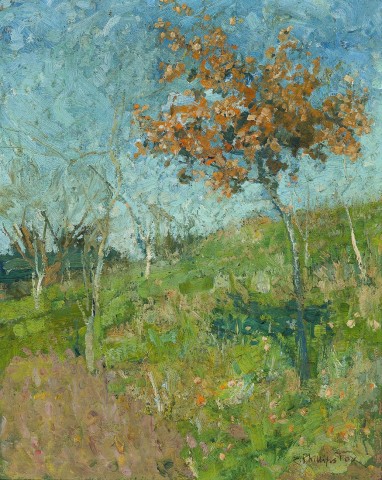AUTUMN HILLSIDE, HEIDELBERG, c.1900
EMANUEL PHILLIPS FOX
oil on canvas
51.0 x 40.5 cm
signed lower right: E. Phillips Fox
Private collection, Melbourne
Thence by descent
Private collection, Sydney
Atmospheric landscapes and notable portraits covered the walls of the Old Court Studio in Melbourne’s Swanston Street for Emanuel Phillips Fox’s solo exhibition of October 1900. Chief among the latter was Portrait of My Cousin, 1893 – 94, which was awarded a gold medal in Paris at the 1894 Salon de la Société des Artistes Français. (The painting was acquired by the National Gallery of Victoria, Melbourne, through the Felton Bequest many years later). There were also many other highlights among the landscapes in the Melbourne exhibition. Autumn Showers, 1900 (purchased the same year for the Art Gallery of New South Wales), was described by The Age art critic as: ‘a landscape conspicuous for the vigor and dexterity of the execution’.1 Autumn Moonrise, 1900 was the original version from which he painted Moonrise, Heidelberg, 1900 (National Gallery of Victoria). Of the others, Moonrise Summer Evening, 1900 is now in the collection of the Tasmanian Museum and Art Gallery, Hobart and The Pines, 1900 is in The Australian Club, Melbourne. The Age reported that most of the portraits and landscapes were recent: ‘Nearly all’ being ‘shown for the first time’, adding: ‘Color in the 30 odd works that hang on the four studio walls is so opulent, so vibrating, so exquisitely delicate and fresh, that it would stir the perceptions of those least sensitive to its charm’.2 The scenes were chiefly of Heidelberg, especially Charterisville, of land and unkempt garden rising above the Yarra River. Fox had favoured autumnal visits there since 1894.
The title of our painting has been lost in the past. And while titles of other landscapes listed in the 1900 exhibition catalogue – particularly Autumn Morning, Fallen Leaves and Dying Autumn – tempt, they elude identification with our painting. The given name ‘Autumn Hillside, Heidelberg’, c.1900 is therefore descriptive, the painting’s style and subject being very much in keeping with Fox’s plein air works of Charterisville from the turn of the century. Full of Impressionist and seasonal verve, trees outlined against the rising hillside recall The Pines and particularly the larger painting, The Spring, 1900 (private collection).3 The lively, broken brushwork, characteristic of Fox’s landscape paintings of this time, creates an appealing picture surface, the rich textures and patterns of light adding to its atmospheric freshness. The dominance of green that the Fox scholar Ruth Zubans noted in his Charterisville palette is now challenged by the striking contrast of orange-gold against blue, continued across the foreground wilderness in the luxury of soft grass and engagingly seductive touches of pink.4 The muted colour range of gentle twilight panoramas is blown away by the sparkle of sunlight, dash of brushstrokes and burst of painterly energy married to colour. It is all the more effective by being seen close up, intimate yet lively. Life is in the fullness of its ‘mellow fruitfulness’, that shortness of shadow cast by the main tree indicating a closeness to midday. Yet, all is enveloped in the maturing, changing atmosphere of autumn.
1. ‘Art Notes’, The Age, Melbourne, 17 October 1900, p. 5
2. ibid.
3. Zubans, R., E. Phillips Fox: His Life and Art, The Miegunyah Press, Melbourne University Press, Melbourne, 1995, cat. 97 and 102
4. ibid., p. 125
DAVID THOMAS
